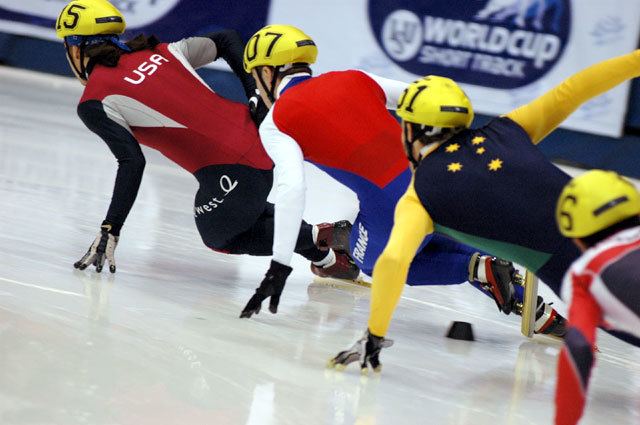Mixed gender Yes | ||
 | ||
Highest governing body International Skating Union Equipment ice skates, helmet, gloves, suit Olympic 1988 (demonstration)
1992 - present | ||
Short track speed skating is a form of competitive ice speed skating. In competitions, multiple skaters (typically between four and six) skate on an oval ice track with a circumference of 111.111 metres (364.54 ft). The rink itself is 60 metres (200 ft) by 30 metres (98 ft), which is the same size as an international-sized ice hockey rink. Short track speed skating is the sister sport to long track speed skating.
Contents
History
Short track speed skating originated in the speed skating events held with mass starts. This form of speed skating was mainly practiced in the United States and Canada, as opposed to the international form, where skaters skated in pairs. At the 1932 Winter Olympics, speed skating events were conducted in the mass start form. Competitions in North America were also held indoors, for example in Madison Square Garden, New York, and therefore on shorter tracks than usual for outdoor skating.
In 1967, the International Skating Union adopted short track speed skating, although it did not organize international competitions until 1976. World Championships have been held since 1981 (though events held in 1976-1980 under different names later received the status of World Championships). After several changes in the name of the competition (last time in 1989), the event is now held annually as the World Short Track Speed Skating Championships.
At the 1988 Winter Olympics, held in Calgary, Alberta, Canada, short track was a demonstration sport. It was upgraded to a full Olympic sport in 1992 and has been part of the Winter Olympics since. The programme was expanded from four events in 1992 to eight in 2002. The events are the same for both men and women: 500 m, 1000 m, 1500 m, 3000m, and the relay (5000 m (men)/3000 m (women)).
Rules
There are several actions that will result in skaters being disqualified from a race, and having their time rendered invalid.
Classes
In Canada, short track competitions are held either as all-points meets, where skaters are seeded based only on their times for a standard distance (usually the 500m), or an age class, where people are seeded by age and gender. All-points meets allow racing against skaters of all ages and genders, with the exception of the Masters age class (30+). All-points meets are usually held at the local level in only certain provinces. Age class meets are utilized at the provincial and national levels. Age classes are:
Ages are determined as of July 1 or June 30 prior to competition. At International and Olympic competitions, skaters are placed by gender only.
Notable skaters
The following is the list of athletes who are Individual gold medalist at the Olympic Winter Games or Overall World Champion and who have won Olympic Winter Games or Overall World Championships at least three times.
